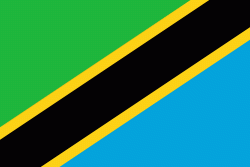Kongwa (Kongwa)
Kongwa is a town and an administrative ward in the Kongwa District of the Dodoma Region of Tanzania. According to the 2012 census, the ward has a total population of 13,531, with an average household size of 4.6.
Kongwa was the centre of the Tanganyika groundnut scheme, which was run by the Overseas Food Corporation (OFC) until the project was brought to an end in 1951. The facilities provided included a hospital, which still serves local patients. A school was established, originally for the children of expatriate staff of the OFC. This continued at Kongwa for a total of ten years until its closure in 1958.
From 1964 onwards, sites in the Kongwa area were used for training purposes by SWAPO and FRELIMO and, in due course, by other movements including African National Congress, MPLA and ZAPU.
Six kilometres from Kongwa itself is St Philips Theological College, which serves the Anglican Church of Tanzania. It was established in 1913 and provides training for Christian ministry in the Anglican and other churches, including some students from neighbouring countries.
Kongwa was the centre of the Tanganyika groundnut scheme, which was run by the Overseas Food Corporation (OFC) until the project was brought to an end in 1951. The facilities provided included a hospital, which still serves local patients. A school was established, originally for the children of expatriate staff of the OFC. This continued at Kongwa for a total of ten years until its closure in 1958.
From 1964 onwards, sites in the Kongwa area were used for training purposes by SWAPO and FRELIMO and, in due course, by other movements including African National Congress, MPLA and ZAPU.
Six kilometres from Kongwa itself is St Philips Theological College, which serves the Anglican Church of Tanzania. It was established in 1913 and provides training for Christian ministry in the Anglican and other churches, including some students from neighbouring countries.
Map - Kongwa (Kongwa)
Map
Country - Tanzania
 |
 |
| Flag of Tanzania | |
Many important hominid fossils have been found in Tanzania, such as 6-million-year-old Pliocene hominid fossils. The genus Australopithecus ranged across Africa between 4 and 2 million years ago, and the oldest remains of the genus Homo are found near Lake Olduvai. Following the rise of Homo erectus 1.8 million years ago, humanity spread all over the Old World, and later in the New World and Australia under the species Homo sapiens. H. sapiens also overtook Africa and absorbed the older species of humanity. Later in the Stone and Bronze Age, prehistoric migrations into Tanzania included Southern Cushitic speakers who moved south from present-day Ethiopia; Eastern Cushitic people who moved into Tanzania from north of Lake Turkana about 2,000 and 4,000 years ago; and the Southern Nilotes, including the Datoog, who originated from the present-day South Sudan–Ethiopia border region between 2,900 and 2,400 years ago. These movements took place at about the same time as the settlement of the Mashariki Bantu from West Africa in the Lake Victoria and Lake Tanganyika areas. They subsequently migrated across the rest of Tanzania between 2,300 and 1,700 years ago.
Currency / Language
| ISO | Currency | Symbol | Significant figures |
|---|---|---|---|
| TZS | Tanzanian shilling | Sh | 2 |
| ISO | Language |
|---|---|
| AR | Arabic language |
| EN | English language |















